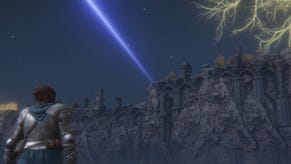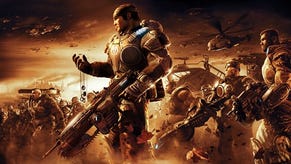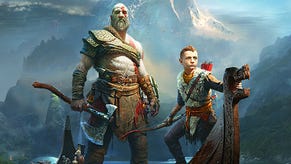"Cory Barlog Kept Punching Guys Forever:" The Making of God of War's Leviathan Axe
God of War's development team talks about building Kratos' now iconic axe.
This article first appeared on USgamer, a partner publication of VG247. Some content, such as this article, has been migrated to VG247 for posterity after USgamer's closure - but it has not been edited or further vetted by the VG247 team.
God of War's Leviathan Axe has garnered almost universal praise from both reviews and fans. The Verge wrote an entire ode to it, calling it the game's "real star."
The Leviathan Axe works on multiple levels. It's a satisfyingly powerful way to cleave enemies; it looks cool, and it can be used as a projectile, dramatically expanding the range of encounter possibilities. The result is exciting tactical combat that mixes elements of both the original game's melee combat and third-person shooters like Last of Us.
It wasn't always that way, though. As originally conceived, the Leviathan Axe was fairly ordinary. But with the camera being moved in so close, the team was having trouble with enemies flanking and surrounding Kratos.
"We were certain we needed a ranged attack, and before we attempted having the Axe fire some kind of projectile," lead systems designer Vincent Napoli recently wrote on his personal blog, "we wanted to see if we could just throw the weapon itself. Hitting an enemy with a solid / large object is just more satisfying than using a projectile/particle effect."
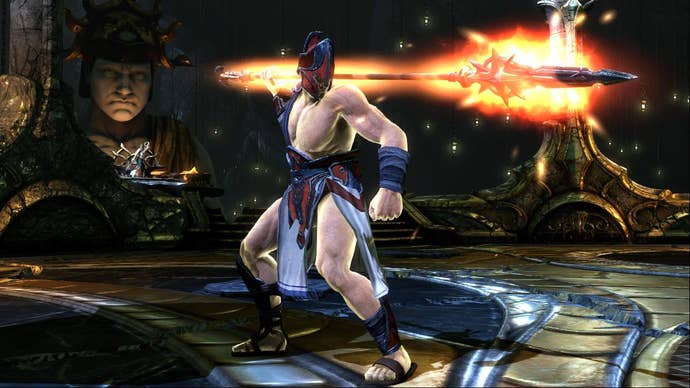
Sony Santa Monica soon turned to God of War Ascension for ideas on how to make a throwing axe workable, lead gameplay designer Jason McDonald told USgamer in an interview before release. "I think we actually took one of our old [God of War Ascension] animations where the character would throw the spear and it would come back and we put it on there to see what it would look like with the new camera perspective. That's when it started to feel at home."
Sony Santa Monica spent months of development time tweaking little elements like the flight path of the Leviathan Axe. In his blog post, Napoli talks about adding a "little programmatic wiggle" just before it comes flying back, adding weight to the overall experience.
"After we moved on to an additive animation that would allow the freedom to navigate, block or evade, we reworked the animation aesthetically quite a bit," Napoli writes. "The first thing we did: make it feel more casual and less stressful by simply lowering his arm. The second thing we did was rotate Kratos towards the camera, in order to play into the camera a bit more so you could see more of his chest /upper body and not just his back. We also really emphasized both the initial recall moment and the catch moment with a few specifically placed frames and zero tween time. We wanted the beginning of the recall to feel weighty, almost like a mini-attack, something forceful."
It wasn't always easy. Napoli writes that despite knowing what they wanted to do with the axe as far back as 2015, they were still tweaking it just a few months before launch. Little tweaks like how long it would take to come back to Kratos's hand would throw everything off.
Their hard work has paid off though, because the result looks and feels fantastic. It's certainly one of the single best elements of God of War's combat. But it wasn't the final piece of the puzzle. Indeed, Sony Santa Monica had to answer one very important question: What happens after the axe is thrown?
God of War's Fists: The Other Piece of the Puzzle
"We figured that you could basically punch people," Napoli remembers. "We started really small—we didn't want to commit to a full weapon. But Cory Barlog kept not calling the axe back and punching guys forever, and it was driving us crazy. We wondered if he was forgetting about the axe, but he said he just liked punching people. So we forced the issue and kept building up [the fists] until it became kind of a second weapon."
Kratos' fists eventually became the other essential ingredient in God of War's combat. After throwing the axe, you can move in and starting pounding away at foes until an on-screen prompt appears, upon which Kratos literally tears them apart. Some enemies are more susceptible to the axe, others to being punched.
It also enables even greater strategic possibilities. To wit, the axe can be used to freeze enemies, making it possible to quickly turn toward other threats while they're immobilized. The result is a naturally symbiotic relationship, with the fists and shield serving as the ying to Kratos' yang.
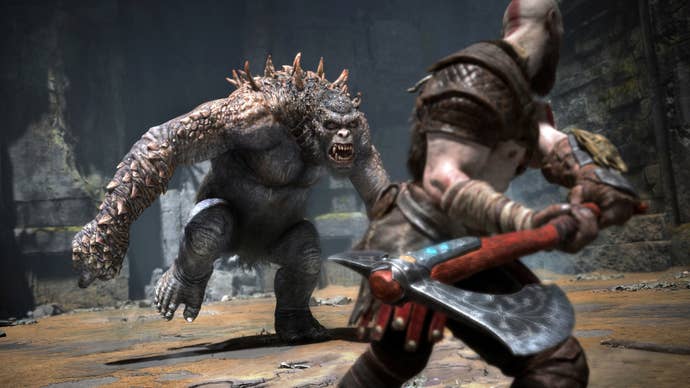
As God of War progresses, even more options become available. Kratos can sweep enemies and keep them on the ground; he can hit enemies with area of effect attacks, and he can activate combos that conclude with brutal uppercuts with the axe. His options are further expanded by Atreus, who can distract enemies with his bow or simply leap on their back, and the shield, which is essential for rapid counter attacks.
All of this is enabled by the new camera, McDonald says. "[W]hen we got the throwable axe system in there, it became possible to get to iron sight view really fast with the camera already there. We really wanted to make sure Kratos could handle enemies at range as well as close by, and being able to aim your axe really puts a new spin on that compared to the old games."
The combat may ultimately be what God of War is best remembered for—a rare thing in a triple-A action game that is trying to be as mainstream as possible. God of War could have been a relatively simple hack-and-slack action game with spells and projectiles. Instead, it's one of the deepest action games of the year.
But in the end, it all comes back to how good it feels to throw the axe. Mike writes in his God of War review, "[Throwing the axe] is immensely satisfying: there's a welcome thunk when the axe lands in a target and another when it returns to Kratos' hand, accompanied by a shake of the DualShock 4. It just feels good to throw the Leviathan Axe and recall it over and over again."
Napoli, for his part, hails it as one of God of War's biggest achievements. "Despite how much work it took, this mechanic might be the one I'm most proud of in the game. Of course we took some inspiration from a certain Marvel character... but from a [gameplay] standpoint I feel like it really did open a lot of doors we weren't expecting."
God of War is now available on PS4. Feeling stuck? Check out our complete God of War walkthrough.


